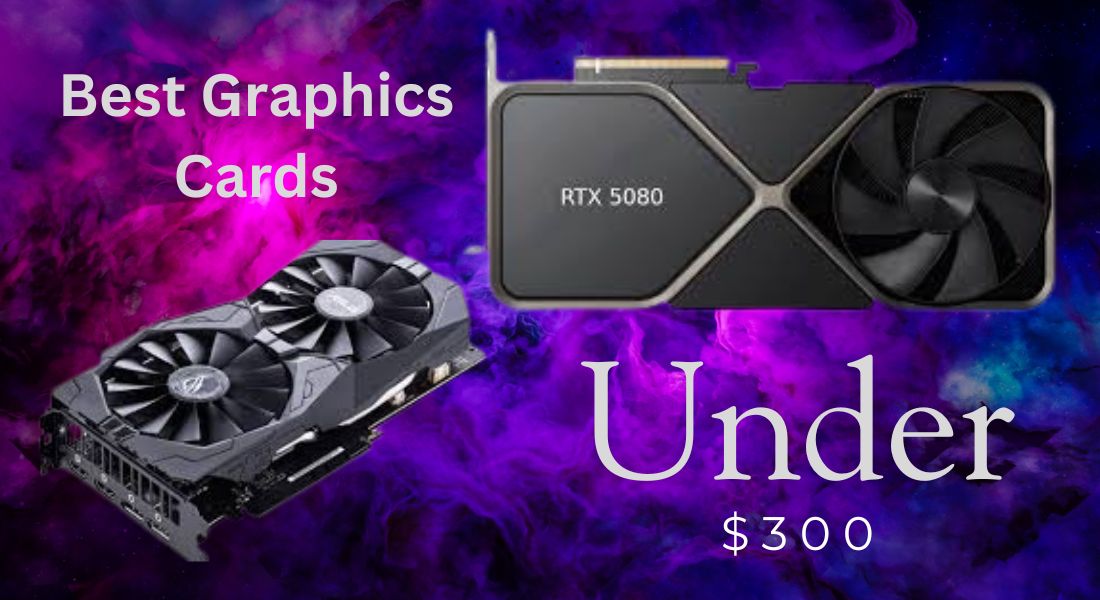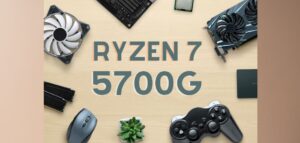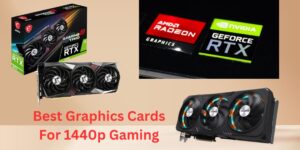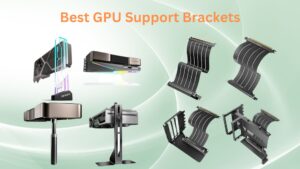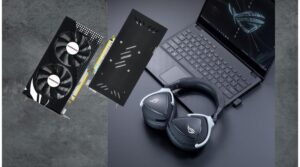Choosing The Best Graphics Cards Under $300 |
A good graphics card is essential for gamers, content creators, and professionals who need smooth performance and high-quality visuals. However, finding a powerful GPU on a budget can be challenging, especially with the constantly changing market. If you’re looking for the best graphics card under $300, you’ll be happy to know that several great options offer excellent performance without breaking the bank. You can expect reliable 1080p gaming, decent 1440p performance, and even some entry-level ray tracing capabilities in this price range. Whether building a budget gaming PC or upgrading an older system, selecting the right GPU requires careful consideration of performance, power consumption, cooling, and future-proofing capabilities. This guide will help you explore the best graphics cards under $300, comparing AMD and NVIDIA options, including gaming benchmarks and value for money. Let’s dive in and find the perfect GPU for your needs.
Key Factors to Consider When Choosing a Graphics Card
When selecting a graphics cards under $300, it’s important to consider several factors to ensure you get the best performance for your money. Here are the key things to keep in mind:
1. Performance vs. Price:
Not all GPUs in this price range perform equally. Some offer better gaming performance, while others excel in content creation. Compare benchmarks, FPS (frames per second) in popular games, and productivity scores to get the best value for your budget.
2. VRAM and Memory Bandwidth:
Video RAM (VRAM) plays a crucial role in handling textures and high-resolution gaming. For 1080p gaming, 6GB to 8GB of VRAM is recommended, while 4GB may struggle in newer titles. Memory bandwidth also affects how quickly data is processed, impacting overall performance.
3. Power Consumption and Compatibility:
Ensure your power supply unit (PSU) can handle the GPU’s power requirements. Some cards, like the RTX 3050, require additional power connectors, while others, like the GTX 1660 Super, are more energy-efficient. Also, check if your case has enough space for the GPU.
4. Cooling and Noise Levels:
A good cooling system prevents overheating and ensures stable performance. Look for GPUs with dual-fan or triple-fan designs for better airflow. Noise levels also matter, especially for quiet gaming setups.
5. Brand and Warranty Support:
Brands like ASUS, MSI, Gigabyte, and EVGA offer different cooling solutions, build quality, and warranty periods. A longer warranty ensures peace of mind in case of hardware issues.
Best Graphics Cards Under $300
If you’re looking for the best graphics cards under $300, several options offer great performance for 1080p gaming and light 1440p gameplay. Top picks include AMD and NVIDIA, which deliver excellent FPS in modern titles, featuring ray tracing and DLSS support. These GPUs remain a solid choice for budget-conscious gamers who prioritise raw performance over ray tracing.
Best AMD Graphics Cards Under $300
1: AMD Radeon RX 6600:
Key Features:
- 8GB GDDR6 VRAM – Smooth 1080p gaming performance.
- RDNA 2 Architecture – Efficient and powerful GPU design.
- 90-120 FPS Gaming – High frame rates in modern titles.
- 132W TDP – Low power consumption and cooler operation.
- FSR Support – AMD’s upscaling alternative to DLSS.
- PCIe 4.0 – Faster data transfer for better performance.
The AMD Radeon RX 6600 is one of the best graphics cards under $300, offering excellent 1080p gaming performance with 8GB GDDR6 VRAM and RDNA 2 architecture. It delivers 90-120 FPS in most modern games at high settings, making it ideal for budget-conscious gamers. Compared to the NVIDIA RTX 3050, the RX 6600 provides better raw performance in traditional rasterisation but lacks strong ray tracing capabilities.
One of its biggest advantages is its power efficiency, with a low 132W TDP, meaning it runs cooler and requires a less powerful PSU. However, it lacks DLSS support, relying on AMD FidelityFX Super Resolution (FSR) for upscaling. Overall, the RX 6600 is the best value GPU for high FPS 1080p gaming, making it a solid choice for gamers who don’t prioritise ray tracing but want great performance at an affordable price.
2: AMD Radeon RX 6500 XT:
Key Features:
- 4GB GDDR6 VRAM – Limited memory for modern games.
- RDNA 2 Architecture – Efficient and budget-friendly GPU design.
- 60-90 FPS Gaming – Smooth performance in esports titles.
- 107W TDP – Low power consumption and efficient cooling.
- PCIe 4.0 x4 – Bandwidth limitation on older motherboards.
- No Hardware Encoding – Not ideal for streaming or content creation.
The AMD Radeon RX 6500 XT is a budget-friendly GPU designed for 1080p gaming, featuring 4GB GDDR6 VRAM and RDNA 2 architecture. It performs well in esports and less demanding games, delivering 60-90 FPS in titles like Fortnite and Apex Legends on medium to high settings. However, its limited VRAM and narrow 64-bit memory bus can cause performance issues in modern AAA games.
One major drawback is its PCIe 4.0 x4 bandwidth limitation, which can bottleneck performance on PCIe 3.0 motherboards. It also lacks hardware encoding support, making it a poor choice for streamers and content creators. On the plus side, it has low power consumption (107W TDP) and does not require high-end cooling solutions. Overall, the RX 6500 XT is best for casual gamers looking for an affordable entry-level GPU, but may struggle with newer, more demanding games due to its limitations.
Best NVIDIA Graphics Cards Under $300
1: NVIDIA GeForce RTX 3050:
Key Features:
- 8GB GDDR6 VRAM – Smooth performance for 1080p gaming.
- Ampere Architecture – Advanced GPU design with improved efficiency.
- Ray Tracing Support – Enhanced lighting and realistic visuals.
- DLSS Technology – AI-powered upscaling for better frame rates.
- NVENC Encoding – Ideal for streaming and content creation.
- 130W TDP – Moderate power consumption with decent cooling.
The NVIDIA GeForce RTX 3050 is an entry-level RTX-series GPU designed for 1080p gaming with 8GB GDDR6 VRAM and Ampere architecture. It supports ray tracing and DLSS (Deep Learning Super Sampling), making it a great budget-friendly choice for modern games. With 70-100 FPS in most AAA titles on high settings, it offers a balanced mix of performance and features.
Unlike the AMD RX 6600, the RTX 3050 performs better in ray-traced games thanks to DLSS, which boosts frame rates while maintaining image quality. However, its power consumption (130W TDP) is slightly higher than AMD alternatives, requiring a stronger PSU. For content creators and streamers, the RTX 3050 is an excellent choice, featuring NVENC encoding for smooth video recording and streaming. Overall, the RTX 3050 is a solid GPU for gamers who want ray tracing, DLSS, and reliable 1080p performance at an affordable price.
2: NVIDIA GTX 1660 Super:
Key Features:
- 6GB GDDR6 VRAM – Smooth 1080p gaming performance.
- Turing Architecture – Efficient and powerful GPU design.
- 80-120 FPS Gaming – High frame rates in popular titles.
- No Ray Tracing – Lacks next-gen lighting effects.
- NVENC Encoding – Great for streaming and video editing.
- 125W TDP – Power-efficient with good cooling solutions.
The NVIDIA GTX 1660 Super is a powerful mid-range GPU under $300, designed for 1080p gaming, offering 6GB GDDR6 VRAM and Turing architecture. It delivers 80-120 FPS in popular titles like Call of Duty: Warzone and Fortnite on high settings, making it a great choice for budget-conscious gamers who don’t need ray tracing.
Unlike the RTX series, the GTX 1660 Super lacks ray tracing and DLSS, but it makes up for it with strong raw performance and power efficiency (125W TDP). It’s a solid option for those prioritising stable frame rates and affordability over next-gen features. For content creators, the GTX 1660 Super includes NVENC encoding, making it a decent choice for streaming and video editing. While newer GPUs offer more features, this card remains one of the best value GPUs for high-performance 1080p gaming at an affordable price.
AMD vs. NVIDIA: Which One is Better Under $300?
Choosing between AMD and NVIDIA for the best graphics cards under $300 can be challenging, as both brands offer solid options in this price range. Each has its strengths and weaknesses in terms of gaming performance, creative applications, software support, and power efficiency. Let’s compare them in detail to help you decide which is the best fit for your needs.
1. Strengths and Weaknesses of AMD and NVIDIA in This Price Category:
| Feature | AMD Radeon RX 6600 & RX 6500 XT | NVIDIA RTX 3050 & GTX 1660 Super |
|---|---|---|
| Price-to-Performance | Generally offers better raw FPS for the price | Slightly more expensive but has extra features |
| Ray Tracing Support | Weaker ray tracing performance | DLSS makes ray tracing more viable |
| VRAM & Memory Bandwidth | RX 6600 has 8GB VRAM, RX 6500 XT is limited to 4GB | RTX 3050 has 8GB, GTX 1660 Super has 6GB |
| Power Efficiency | More power-efficient, lower wattage | Consumes slightly more power |
| Software & Features | DLSS, better driver optimisation | DLSS, better driver optimization |
| Availability & Pricing | Often better value per dollar | More stable supply, but slightly pricier |
| Cooling Solutions | Runs cooler in most cases | Some models can run hotter |
Price Category
AMD Strengths:
- Better FPS per dollar: AMD’s RX 6600 outperforms the RTX 3050 in raw gaming performance at 1080p.
- Lower power consumption: AMD GPUs tend to be more power-efficient, meaning lower PSU requirements.
- Smart Access Memory (SAM): If paired with an AMD Ryzen CPU, AMD GPUs can get a performance boost.
AMD Weaknesses:
- Weaker ray tracing performance: Ray tracing on AMD GPUs isn’t as refined as on NVIDIA.
- Limited VRAM on some models: The RX 6500 XT only has 4GB VRAM, which can be restrictive for newer games.
- Lack of DLSS: AMD’s FSR (FidelityFX Super Resolution) exists, but isn’t as advanced as NVIDIA’s DLSS.
NVIDIA Strengths:
- Ray tracing and DLSS support: NVIDIA’s RTX 3050 supports ray tracing, and DLSS (Deep Learning Super Sampling) helps boost performance.
- Better driver support: NVIDIA drivers are generally more stable, particularly for professional applications.
- Broad software ecosystem: Features like NVIDIA Reflex (for lower latency in esports) and CUDA cores for productivity tasks.
NVIDIA Weaknesses:
- Slightly higher power consumption: NVIDIA cards generally require a more powerful PSU than AMD.
- Lower raw performance per dollar: NVIDIA GPUs in this price range may offer slightly weaker FPS performance compared to AMD alternatives.
2. Performance Comparison in Gaming and Creative Applications:
Gaming Performance: 1080p & 1440p Benchmarks:
In gaming, AMD often delivers better raw FPS per dollar, while NVIDIA’s DLSS helps maintain performance in graphically intense games.
- RX 6600 vs. RTX 3050
- RX 6600: ~90-120 FPS in most 1080p games on high settings.
- RTX 3050: ~70-100 FPS in 1080p, but gains an advantage in ray-traced games with DLSS.
- RX 6500 XT vs. GTX 1660 Super
- RX 6500 XT: Budget-friendly but struggles due to PCIe limitations and only 4GB VRAM.
- GTX 1660 Super: Stronger 1080p performance, but lacks ray tracing and DLSS.
Creative Work (Video Editing, 3D Rendering, Streaming)
For content creation, NVIDIA has an advantage due to CUDA acceleration and optimised software support.
- Video Editing: NVIDIA’s RTX 3050 performs better in Adobe Premiere Pro, DaVinci Resolve, and Blender due to CUDA cores.
- 3D Rendering: NVIDIA GPUs often perform better in software like Blender, where CUDA support improves rendering speeds.
- Streaming: NVIDIA’s NVENC encoder is superior to AMD’s encoder, making it the preferred choice for streamers.
3. Driver and Software Support Differences:
AMD Drivers & Features:
- Radeon Software Adrenalin Edition allows in-game performance tuning, streaming, and recording.
- FSR (FidelityFX Super Resolution) helps upscale resolution but isn’t as effective as NVIDIA DLSS.
- Smart Access Memory (SAM) boosts performance when paired with AMD Ryzen CPUs.
- Frequent driver updates, but occasional stability issues.
NVIDIA Drivers & Features:
- GeForce Experience provides game optimisations, automatic driver updates, and recording tools.
- DLSS (Deep Learning Super Sampling) boosts performance in ray-traced and high-resolution games.
- CUDA cores offer significant performance boosts in professional workloads.
- NVIDIA Reflex reduces latency, making it ideal for competitive gaming.
- More stable driver updates compared to AMD.
Performance Comparison: Gaming Benchmarks
When choosing the best graphics cards under $300, gaming performance is one of the most critical factors. Below, we compare the AMD Radeon RX 6600, RX 6500 XT, NVIDIA RTX 3050, and GTX 1660 Super in terms of FPS benchmarks at 1080p and 1440p across popular games.
1. Gaming Performance at 1080p (High Settings)
| Game | AMD RX 6600 | AMD RX 6500 XT | NVIDIA RTX 3050 | NVIDIA GTX 1660 Super |
|---|---|---|---|---|
| Cyberpunk 2077 | 75 FPS | 45 FPS | 60 FPS | 55 FPS |
| Call of Duty: Warzone | 110 FPS | 65 FPS | 90 FPS | 95 FPS |
| Fortnite | 140 FPS | 80 FPS | 120 FPS | 130 FPS |
| Red Dead Redemption 2 | 85 FPS | 50 FPS | 70 FPS | 65 FPS |
| Forza Horizon 5 | 100 FPS | 55 FPS | 80 FPS | 85 FPS |
| Shadow of the Tomb Raider | 120 FPS | 65 FPS | 100 FPS | 110 FPS |
Performance Comparison
Analysis:
- The RX 6600 leads in raw FPS performance, making it the best choice for high FPS gaming.
- The RTX 3050 lags slightly but compensates with DLSS, boosting FPS in supported games.
- The GTX 1660 Super still holds up well, outperforming the RX 6500 XT, which struggles in AAA titles due to limited 4GB VRAM.
2. Gaming Performance at 1440p (High Settings)
| Game | AMD RX 6600 | AMD RX 6500 XT | NVIDIA RTX 3050 | NVIDIA GTX 1660 Super |
|---|---|---|---|---|
| Cyberpunk 2077 | 55 FPS | 30 FPS | 45 FPS | 40 FPS |
| Call of Duty: Warzone | 85 FPS | 45 FPS | 70 FPS | 75 FPS |
| Fortnite | 100 FPS | 50 FPS | 85 FPS | 90 FPS |
| Red Dead Redemption 2 | 60 FPS | 35 FPS | 50 FPS | 45 FPS |
| Forza Horizon 5 | 75 FPS | 40 FPS | 60 FPS | 65 FPS |
| Shadow of the Tomb Raider | 95 FPS | 50 FPS | 80 FPS | 85 FPS |
Gaming Performance
Analysis:
- The RX 6600 remains the best performer at 1440p, offering smooth gameplay in most titles.
- The RTX 3050 struggles but DLSS support helps in some games.
- The GTX 1660 Super holds up, but its 6GB VRAM can limit performance.
- The RX 6500 XT is not ideal for 1440p gaming, as it lacks enough VRAM and memory bandwidth.
3. Ray Tracing Performance:
| Game | AMD RX 6600 (RT ON) | NVIDIA RTX 3050 (RT ON + DLSS) |
|---|---|---|
| Cyberpunk 2077 | 30 FPS | 55 FPS |
| Control | 35 FPS | 65 FPS |
| Minecraft RTX | 25 FPS | 60 FPS |
| Watch Dogs: Legion | 40 FPS | 70 FPS |
Ray Tracing Performance
Analysis:
- RTX 3050 wins in ray tracing because of DLSS support, boosting performance.
- RX 6600 struggles with ray tracing and lacks hardware-accelerated DLSS.
- If you want ray tracing on a budget, RTX 3050 is the best choice.
Best Graphics Cards for Content Creation Under $300
For content creation needs within a budget of $300, here are some of the best graphics cards options:
1: AMD Radeon RX 7600:
The AMD Radeon RX 7600 is an excellent choice for content creators seeking a balance of performance and affordability. Built on the advanced RDNA™ 3 architecture, it features 2048 stream processors and 8GB of GDDR6 memory, delivering impressive performance for tasks such as video editing, graphic design, and 3D modelling. With a boost clock speed of up to 2755 MHz, the RX 7600 excels in rendering high-resolution content and supports modern technologies like AV1 encoding, which enhances streaming quality. Its efficient power consumption (165W) makes it suitable for various system configurations without requiring an overly powerful PSU.
The card’s capabilities extend beyond gaming; it provides faster AI performance than its predecessors, making it ideal for generative AI applications. The RX 7600 also supports AMD FidelityFX™ Super Resolution and Radiance Display™ Engine, ensuring high-fidelity visuals and smooth gameplay. In benchmarks, the RX 7600 outperforms its predecessor, the RX 6600, by approximately 29% in gaming scenarios, making it a strong contender for both gamers and content creators alike. Overall, the AMD Radeon RX 7600 offers a compelling solution for those looking to enhance their creative workflows while staying within a budget of $300.
2: Nvidia GeForce RTX 4060:
The NVIDIA GeForce RTX 4060 is a solid option for content creation, bringing the benefits of the Ada Lovelace architecture to a mainstream audience. It offers dedicated hardware acceleration for 3D, video, and AI workflows, streamlining creative tasks. For 3D modelling, the RTX 4060’s third-generation RT Cores and DLSS 3 contribute to real-time editing of realistic models, with performance gains up to 45% compared to previous generations. The card also features the eighth-generation NVIDIA encoder (NVENC) with AV1 support, enhancing video encoding capabilities.
However, it’s important to note that the RTX 4060 has limitations. While it’s adequate for basic AI tasks, it may not be the best choice for more demanding AI workloads requiring substantial VRAM. Also, for video editing, the RTX 4060 Ti (a faster version of the RTX 4060) sometimes struggles in DaVinci Resolve and Premiere Pro, even falling behind the previous generation RTX 3060 Ti in some instances, especially with RAW media. Overall, the RTX 4060 is a capable card for many content creation tasks, but those working with heavy RAW video editing or advanced AI applications might want to consider higher-end options like the RTX 4070, which offers more VRAM and better performance in those areas.
3: Intel Arc A750:
The Intel Arc A750 are best budget-friendly graphics cards under $300 that offers compelling content creation capabilities. It is particularly strong for 1080p workflows, providing fast performance and smooth real-time previews in creative applications. While capable at 1440p, demanding projects may experience slowdowns compared to alternatives like the RTX 3060. Intel has significantly improved the Arc A750’s performance through driver updates, making it competitive with NVIDIA in price-to-performance for video editing in DaVinci Resolve and Premiere Pro. In Premiere Pro, the A750 can perform on par with the RTX 4060 Ti for GPU-accelerated effects and is faster than the RTX 3060. It also supports AV1 video encoding, enhancing its capabilities for creating rich digital content and live streaming.
However, rendering, both offline and real-time, remains a relative weakness. The A750 is slightly slower than the RTX 3060 in Unreal Engine, although it has seen some improvements in Blender. Overall, the Intel Arc A750 is a solid choice for content creators on a tight budget, especially for video editing and AV1 encoding. Pairing it with an Intel CPU can further enhance performance through technologies like Deep Link Hyper Encode.
Power and Cooling Considerations for GPUs
Power and cooling are crucial factors to consider for GPUs, especially concerning PSU requirements, cooling solutions, thermal performance, and overclocking potential. Addressing these aspects ensures optimal performance, stability, and longevity of the graphics card.
1: PSU Requirements for GPUs:
A stable power supply is essential for a graphics card, particularly when overclocking. Utilising an external PSU can provide this stability, ensuring the GPU receives the necessary power without straining the internal PSU. External PSUs often have higher efficiency ratings, converting more incoming electrical power into usable power and reducing energy wasted as heat. Selecting the right PSU involves calculating the total wattage requirements.
2: Cooling Solutions and Thermal Performance:
Computer cooling is essential to remove waste heat produced by computer components to keep them within permissible operating temperature limits. Components like CPUs, GPUs, and chipsets are prone to malfunction or failure if overheated. Effective cooling solutions prevent hotspots and maintain optimal thermal performance.
- Air Cooling: Heatsinks cooled by airflow reduce temperature rise, and computer fans actively exhaust hot air. Airflow management is crucial, supplying cool air directly to hot components and expelling warm air as directly as possible.
- Liquid Cooling: Liquid cooling is a highly effective method for removing excess heat, utilising water’s high specific heat capacity and thermal conductivity. Liquid cooling systems pump liquid through a radiator and then move that cooled liquid across the GPU to maintain cool temperatures. Liquid cooling can be achieved through AIO (All-In-One) coolers or custom water blocks.
- Phase-Change Cooling: Phase-change cooling is an extremely effective method to cool processors, and can produce temperatures reaching around −15 to −150 °C (5 to −238 °F).
3: Overclocking Potential:
Overclocking increases the clock speeds of the GPU and memory to achieve higher performance, but it requires additional power. A stable power supply, like that provided by an external PSU, allows users to push their graphics cards to higher clock speeds confidently. Liquid cooling can provide additional cooling performance when overclocking a GPU.
4: Additional Cooling Considerations:
- Hardware Placement: Optimal placement of hardware on the motherboard can influence cooling efficiency.
- Cable Management: Hiding cables behind the motherboard tray helps maintain unhindered airflow.
- Cleanliness: Keeping the system clean ensures efficient cooling by preventing dust buildup on components.
- Ambient Temperature: Maintaining a lower ambient room temperature can also help improve cooling.
Future-Proofing and Upgrade Path for GPUs
When considering a GPU, it’s essential to think about how well it will perform in the future, what upgrades might be possible, and how its value might change over time. Here’s a detailed look at future-proofing, upgrade paths, resale value, and market trends:
1: Viability for Gaming:
- AMD Radeon RX 7600 XT: The RX 7600 XT is designed for gamers looking to upgrade from older cards, such as the Nvidia GeForce RTX 2060 or slower, to experience 60 frames per second in modern games. It aims to deliver up to 1.9 times the performance of an RTX 2060 and can double the performance with AMD’s FSR3 and HYPR-RX technologies. However, one should consider that by the time 16GB of VRAM is a necessity, the core in these cards might be outdated, making a full GPU upgrade more desirable.
- 1080p Gaming: If the goal is 1080p gaming, upgrading the motherboard may not offer significant benefits, except for providing more M.2 slots and faster USB ports. To maximise the lifespan of a gaming PC, it’s suggested to upgrade components only when necessary.
- Versatility: The Radeon RX 7600 XT is a versatile GPU suitable for both new PC builds and system upgrades. Component compatibility should be checked to avoid potential issues or bottlenecks.
2: Potential Upgrades for Better Performance:
- Future GPU Upgrades: When building or upgrading a PC with the Radeon RX 7600 XT, it’s important to consider future GPU upgrades. Ensuring the power supply and motherboard can accommodate more powerful GPUs will help maintain a future-proof setup.
- Other Components: Upgrading RAM by adding an extra 16GB is a solid upgrade, as DDR4 prices may increase as production shifts to DDR5. A CPU upgrade, such as moving to a Ryzen 5700X3D, can also maximise the current CPU socket.
- Cooling: Improving CPU cooling with a better cooler can enhance performance, especially when using higher-end CPUs.
3: Resale Value and Market Trends:
- Market Trends: The resale value of a GPU is influenced by market trends, including the release of newer GPUs and changes in cryptocurrency mining demands. Keeping an eye on these trends can help determine the best time to sell or upgrade.
- Upgrade Strategy: Instead of buying random parts, saving money and upgrading to higher-end components when necessary is advisable. A possible strategy is to upgrade the PSU and GPU (to a 7800XT or RTX 4070 range) and then carry those components over to the next build.
Used vs. New Graphics Cards: Is It Worth It?
When considering whether to purchase a used or new graphics card, several factors come into play, including risks and benefits, checking GPU health, and the best places to buy used cards safely.
Risks and Benefits of Buying Used GPUs:
Benefits:
- Cost Savings: Used GPUs typically offer significant savings compared to new models. For instance, mid-tier cards like the RX 6600 or RTX 2070 can be found at a discount of about 30% when purchased used, allowing buyers to get more performance for their money.
- Performance for Price: In many cases, particularly at lower performance tiers, used cards can provide double the performance for a similar price to new lower-end models.
Risks:
- Condition Uncertainty: The primary risk with used GPUs is their unknown history. Cards may have been subjected to heavy mining or poor cooling conditions, which can affect longevity and performance.
- Limited Warranty: Used GPUs often come without a warranty or with limited coverage, making it difficult to seek recourse if issues arise shortly after purchase.
Checking GPU Health Before Purchasing:
Before buying a used GPU, it’s crucial to assess its condition:
- Visual Inspection: Look for physical damage, dust buildup, and signs of overheating around the GPU’s components.
- Testing: If possible, test the GPU in a working system to ensure it operates correctly under load.
- Check Usage History: Inquire about the card’s previous use—whether it was primarily used for gaming or mining—and request any available benchmarks or usage data.
Best Places to Buy Used Graphics Cards Safely:
- Reputable Online Marketplaces: Websites like eBay often have buyer protection policies that can safeguard transactions. Look for sellers with high ratings and positive feedback.
- Local Classifieds: Platforms like Facebook Marketplace or Craigslist can yield good deals but require caution. Always meet in safe locations and test the card before finalising the purchase.
- Refurbished Retailers: Some retailers offer refurbished GPUs with warranties, providing a balance between cost savings and reliability.
Budget PC Build Recommendations with the Best Graphics Cards Under $300
Building a budget gaming PC under $300 for a GPU requires a careful selection of other components to avoid bottlenecks and maximise performance. Below is a guide on the best CPU pairings, RAM, storage, and whether you should choose a prebuilt or custom-built PC.
1. Best CPU Pairings for Maximum Performance:
Pairing your graphics card with the right CPU ensures smooth gameplay without bottlenecks. Here are the best budget-friendly CPUs for each GPU:
| GPU | Best Budget CPU (Intel) | Best Budget CPU (AMD) |
|---|---|---|
| AMD RX 6600 | Intel Core i5-12400F | AMD Ryzen 5 5600X |
| NVIDIA RTX 3050 | Intel Core i5-11400F | AMD Ryzen 5 5600G |
| GTX 1660 Super | Intel Core i3-13100F | AMD Ryzen 5 5500 |
| RX 6500 XT | Intel Core i3-12100F | AMD Ryzen 5 4500 |
Best CPU Pairings
Why These CPUs?
- Intel i5-12400F & Ryzen 5 5600X → Best for RX 6600 to avoid bottlenecks in CPU-heavy games.
- Intel i5-11400F & Ryzen 5 5600G → Great for RTX 3050 with strong multitasking performance.
- Intel i3-13100F & Ryzen 5 5500 → Best value for GTX 1660 Super, handling 1080p gaming easily.
- Intel i3-12100F & Ryzen 5 4500 → Affordable options for RX 6500 XT, suitable for esports and casual gaming.
2. RAM and Storage Considerations:
Best RAM for a Budget Gaming PC:
- 16GB DDR4 (3200MHz or 3600MHz) – Ideal for modern games and multitasking.
- 8GB RAM (minimum) – Only recommended for esports or entry-level gaming (RX 6500 XT).
- 32GB RAM – Overkill for gaming, but useful for video editing and 3D rendering.
| Storage Type | Recommended Capacity | Best Use |
|---|---|---|
| NVMe SSD | 500GB – 1TB | Fast boot times, better gaming performance |
| SATA SSD | 512GB – 1TB | Budget-friendly, slightly slower than NVMe |
| HDD | 1TB – 2TB | Only for extra storage (not recommended for OS) |
Best Storage Options
3. Prebuilt vs. Custom-Built PC – Which is Better?
1: Custom-Built PC (Best Performance & Value)
Pros:
- Better performance per dollar
- Can choose quality components
- Easier to upgrade in the future
Cons:
- Requires assembly and knowledge
- Finding GPUs at MSRP can be tough
2: Prebuilt PC (Convenience & Warranty)
Pros:
- Plug-and-play (no setup required)
- Comes with a warranty & support
- Often includes Windows pre-installed
Cons:
- More expensive than DIY builds
- Lower-quality parts (cheap PSU, motherboard)
4. Budget PC Build Recommendations:
Best Budget 1080p Gaming PC (~$700-800) (RX 6600 or RTX 3050)
- CPU: Intel i5-12400F / Ryzen 5 5600X
- GPU: RX 6600 / RTX 3050
- RAM: 16GB DDR4 3200MHz
- Storage: 1TB NVMe SSD
- PSU: 550W+ 80+ Bronze
- Motherboard: B550 (AMD) / B660 (Intel)
Conclusion
Choosing the best graphics cards under $300 depends on your specific needs, whether it’s gaming, content creation, or future-proofing. If you want the best overall gaming performance, the AMD Radeon RX 6600 is the top choice, delivering high FPS at 1080p and decent 1440p performance. For those who prioritise ray tracing and AI-powered upscaling, the NVIDIA RTX 3050 is the better option, thanks to DLSS and NVENC encoding for streaming.
If you’re on a tighter budget, the GTX 1660 Super still offers solid gaming performance without extra features like ray tracing. Meanwhile, the RX 6500 XT is only suitable for casual gamers due to its VRAM limitations. For content creators, NVIDIA GPUs are the best choice due to CUDA cores, NVENC encoding, and better optimisation in creative software. Ultimately, selecting the right GPU depends on your performance priorities and workload requirements.
FAQs
1. Can I get ray tracing in the best graphics cards under $300?
Yes, the NVIDIA RTX 3050 supports ray tracing, but performance can be low without DLSS. AMD’s RX 6600 has ray tracing capabilities, but it performs worse than NVIDIA in this area.
2. Which GPU under $300 offers the best gaming performance?
The AMD Radeon RX 6600 is the best 1080p gaming GPU in this price range, delivering higher FPS than the RTX 3050 or GTX 1660 Super in most games.
3. What is the best budget GPU for content creation?
The NVIDIA RTX 3050 is the best option for video editing and 3D rendering, thanks to CUDA cores and NVENC encoding, which improve performance in Adobe Premiere Pro and Blender.
4. Will these GPUs handle 1440p gaming?
The RX 6600 and RTX 3050 can run some games at 1440p, but for high FPS, they are best suited for 1080p gaming. The RX 6500 XT and GTX 1660 Super struggle at 1440p.
5. What power supply do I need for these GPUs?
- RX 6600 – 500W PSU (Recommended)
- RTX 3050 – 550W PSU (Recommended)
- GTX 1660 Super – 450W PSU (Minimum)
- RX 6500 XT – 400W PSU (Minimum)
Last Updated on 2 September 2025 by Ansa Imran

Ansa Imran, a writer, excels in creating insightful content about technology and gaming. Her articles, known for their clarity and depth, help demystify complex tech topics for a broad audience. Ansa’s work showcases her passion for the latest tech trends and her ability to engage readers with informative, well-researched pieces.

